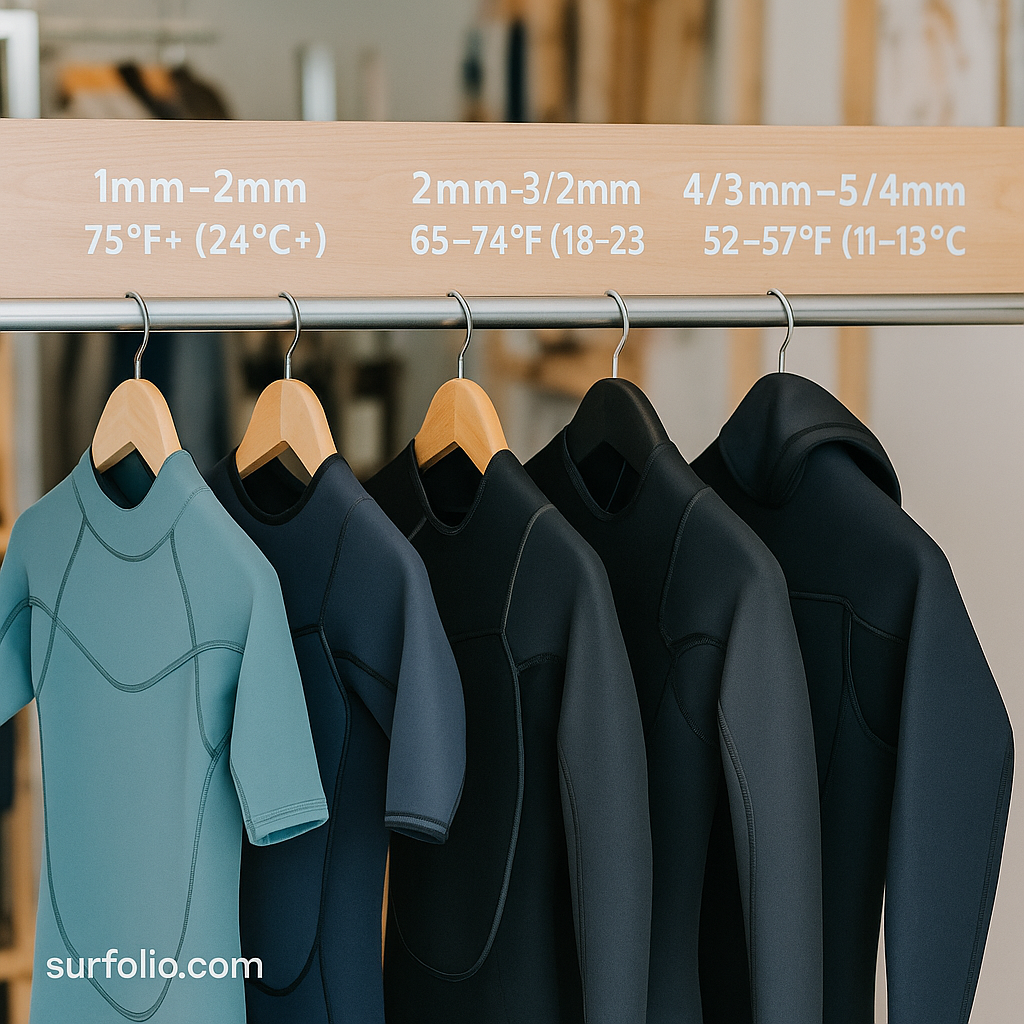
Why Wetsuit Thickness Matters
Your wetsuit isn’t just about comfort—it’s your armor against cold water. The right thickness helps you maintain warmth, conserve energy, and surf longer without stiffness or chill.
A wetsuit that’s too thin won’t retain enough heat, while one that’s too thick limits your paddling and maneuverability. Striking the perfect balance depends on water temperature, wind, and your body’s tolerance to cold.
Wetsuit Thickness Guide by Water Temperature
| Water Temperature | Recommended Thickness | Wetsuit Type | Notes |
|---|---|---|---|
| 75°F+ (24°C+) | 1mm–2mm | Springsuit or Rash Guard | For warm tropical surf and maximum mobility. |
| 65–74°F (18–23°C) | 2mm–3/2mm | Shorty or Full Suit | Ideal for mild conditions with some breeze. |
| 58–64°F (14–17°C) | 3/2mm–4/3mm | Full Wetsuit | Great all-around option for most surfers. |
| 52–57°F (11–13°C) | 4/3mm–5/4mm | Full with Hood or Boots | Keeps you warm in cooler climates. |
| Below 52°F (11°C) | 5/4mm–6/5mm | Hooded Full Suit | For cold-water surf zones like Northern California or the UK. |
What “3/2mm” Actually Means
A wetsuit marked 3/2mm means:
- 3mm thick neoprene on the torso (for warmth)
- 2mm on the arms and legs (for flexibility)
Manufacturers use this combo to keep your core insulated while allowing easier paddling and movement where it counts.
Factors That Influence Wetsuit Choice
1. Wind Chill
Even in moderate temperatures, strong offshore winds can make it feel much colder. A slightly thicker suit can help counteract that.
2. Body Type & Circulation
Some surfers naturally run warmer or cooler. If you tend to get cold quickly, go up by 0.5mm–1mm in thickness.
3. Surf Session Length
Longer sessions demand better insulation—especially if you’re out past the first hour when your core temperature starts to drop.
4. Season & Location
Summer mornings in Southern California aren’t the same as autumn in Portugal or winter in Oregon. Know your local conditions and seasonal shifts.
Wetsuit Fit: Warmth Starts with the Right Size
A perfect-fitting wetsuit should feel snug but not restrictive. Look for:
- Minimal water entry around neck, wrists, and ankles
- No baggy areas or loose folds
- Even compression without limiting range of motion
If it’s too tight, it’ll restrict blood flow; too loose, and cold water will flush in.
Extra Gear for Cold Conditions
- Hood: Prevents major heat loss through your head
- Booties: Keep feet flexible and protected
- Gloves: Add warmth in cold or windy surf
These accessories can often extend your surf time by 30–40% in chilly conditions.
Pro Tip: Neoprene Quality Over Thickness
Modern wetsuits use limestone or Yulex neoprene, which is lighter, more flexible, and warmer than traditional petroleum-based versions. This means a high-quality 3/2mm can perform like an older 4/3mm suit.
Final Thoughts
Choosing the right wetsuit thickness means understanding your environment and your body. The right setup lets you surf comfortably, confidently, and longer—without shivering through the lineup.
When in doubt, try before you buy, and always prioritize fit and flexibility over pure thickness numbers.
